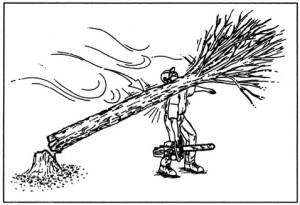BACKGROUND: On an unusually windy day in the Lake States, a sawyer was select-harvesting log cabin poles with a 20-inch chain saw. The sawyer was working under the supervision of the cable skidder operator, who was transporting logs back to the landing.
PERSONAL CHARACTERISTICS: The 26-year-old sawyer had been on the job eleven days and had received instructions on safe felling techniques. He had not had any previous accidents and was considered a reliable worker. However, since he was a new worker, the skidder operator was keeping a close watch over his felling activities.
UNSAFE ACT OR CONDITION: The sawyer had just completed an open-faced notch in the direction he wished to fell a 16-inch diameter tree. He began to prepare an escape path that led directly back from behind the notch.
ACCIDENT: The shifting high winds started to force the tree in the direction opposite to that of the intended fall. The remaining wood broke unexpectedly, and the tree fell, striking the sawyer on the shoulder.
INJURY: The sawyer was stunned and remained unconscious for approximately one minute. He was revived quickly with assistance from the skidder operator. The sawyer was transported to a local emergency room, where he was diagnosed with a compression fracture of the upper back. This injury will prevent him from returning to work as a logger.
RECOMMENDATIONS: High winds signal the possibility of an unplanned incident. It is always best to suspend operations temporarily during inclement weather, rather than risk injury.
A planned escape route, at a 45-degree angle back from the intended direction of fall, offers the best protection from a falling tree when an unexpected event occurs. OSHA requires that the escape path be planned and cleared prior to felling, not after the notch has been made.
 Courtesy of the Forest Resources Association: https://www.forestresources.org/
Courtesy of the Forest Resources Association: https://www.forestresources.org/
